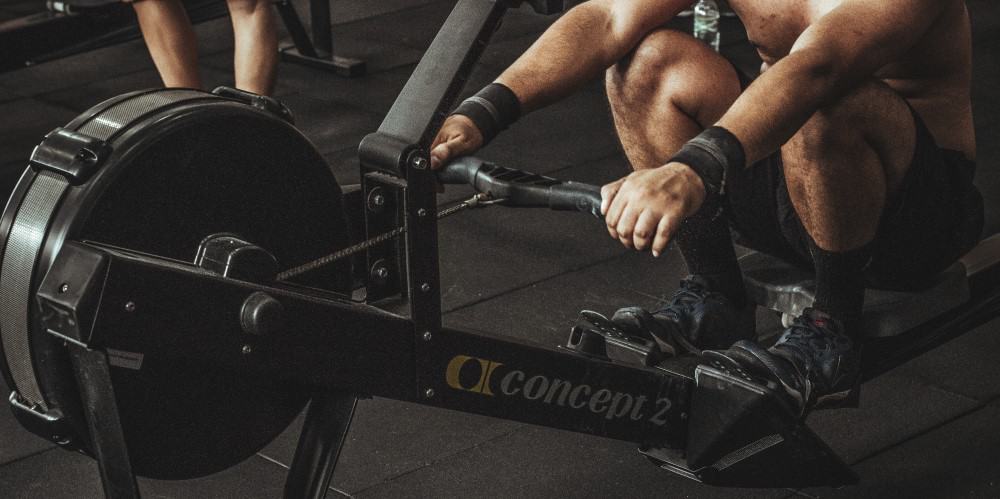In today’s article I will address all about Intensity in Weight Training, how it works and how you can assess your own 1RM (One Repetition Maximum) values with easy formulas or by doing a maximum strength test.

Intensity
Percentage of 1RM
In sports science, the intensity describes the percentage of the actual “working” weight in relation to the maximum force (1RM = One Repetition Max) in the same exercise. So if you can push 100kg on the bench once and bench 80kg in your working set, your intensity is 80%. It does not matter if you do one or five repetitions.
The intensity neither describes the effort of one set nor how much you feel exhausted at the end of the training. You can train with low intensity and at the same time with a very high effort. For example, you would have to do a set of 30 repetitions for muscle failure. The intensity is very low in this case because otherwise, you would not have managed to perform 30 repetitions in one set and the effort extremely high at the same time. Likewise, a single repetition with 85% of the 1RM is probably not particularly strenuous but highly intensive.
The load on the other hand, that is, how many repetitions in one set would theoretically be possible up to muscle failure, is a much better tool to adequately express the effort in one set. Usually, the RPE scale or the RIR method is used. I’ll deal with both of these techniques in a separate article.
Conscious intensities can be assigned to repetitions that would be approximately reached at maximum utilization (muscle failure). These are by no means fixed laws but merely a static means
Why does intensity matter if we want to properly build strength or muscle?
First of all, most training plans indicate the training weights in intensities. So, if you ever come across such a training plan, you know directly what is meant and how you have to implement it.
On the other hand, it seems logical that we need a certain intensity in order to stimulate the best possible muscle growth. Or do you think that biceps curls give you optimal growth with a pen in your hand?
Actually, we are always exposed to the force of gravity and thus train through everyday movements throughout our lives with
Depending on which intensity has been chosen, the body selects the adaptation that seems most appropriate for him. So if you like to train with 50 repetitions, you will improve the most in this very intensity range.
Concretely, this means e.g. a higher lactate tolerance or better energy supply, with sufficient oxygen uptake. In our case, more muscle would simply not be conducive and of
Remember, for the body, it’s about getting better adjusted for the next time to ensure survival. So, if you want to build muscle or strength, you need to work out in one area, as building muscle or strength is the best and most logical adaptation to make for your body.
That’s why volume is not the only factor in building muscle, just the most important one.
Previously, intensities or rep ranges were strictly divided into strength (1-5 Reps), muscle growth (6-12 Reps), and strength endurance (+12 Reps). Today, we know that muscle growth seems to be possible on a very large scale.
However, there are definitely too low intensities to effectively build muscle. In addition, too high intensities can be quite impractical:

So how low is “too low” and how high is “too high”?
1.) intensities between 0-30%:
Seem to induce less muscle gain compared to higher intensities, despite equal volume and high workloads.
2.) intensities between 30-50%:
One study shows that this area is also able to stimulate maximum muscle growth (at the same volume) when exercising very close to muscle failure. But definitely, more research needs to be done to be sure. In any case, the extremely high utilization required to achieve the same results as in 3.) is a major drawback. Anyone who has ever gone through a sentence with 30 reps to complete muscle failure knows the extremely exhausting feeling. Whether one can then keep the concentration high for several
3.) intensities between 50-90%
Probably the optimal range, because you can accumulate here with enough intensity, high volume and without having to perform every set to muscle failure.
4.) intensities between 90-100%:
Probably too heavy to accumulate significant volume. In addition, of course, the risk of injury and exhaustion of the nervous system is greatest here.
Generally, it can be said that intensities between 30-100% could theoretically induce maximum muscle growth. However, in practice, intensities of between 70-85% have been proven, as they are both heavy enough to give the body the muscle building stimuli, and light enough to accumulate a lot of volume without posing a high risk of injury.
In practice this means: About 5-15 repetitions for the best possible muscle growth.
Generally, at lower intensities, higher utilization is needed because not all muscle fibers are activated from the beginning. Especially the fibers with the highest growth potential come into play only when things get really heavy. So if you do a set of 30 reps to failure, so turn on in the last few repetitions. However, if you stop 10 repetitions beforehand, the above-mentioned fibers are not really loaded to the maximum.
So you can divide the volume into 2 phases:
-before maximum fiber recruitment
-during maximum fiber recruitment
Probably the volume at maximum fiber recruitment, we call it the “effective volume“, crucial or very important when it comes to muscle growth. Only in this area are the fibers with the highest growth potential properly required.
Nevertheless, there may well be scenarios in which a very high or low intensity may make sense:
1.) Injuries:
Applying
2.) Powerlifting competitions:
Here it would, of course, make sense to train before the competition in the
Once the competition is over, you should once again take care of raising your potential before you unfold it again through high intensities before the next competition.

1 RM determination
1.) Maximum strength test
The most obvious method of calculating a peak value is a so-called maximum strength test. Basically, you just try out what weight you can handle just once. If the maximum strength test is carried out correctly, the most accurate 1RM value is obtained, since this method does not require any further theoretical calculations. Still, it definitely has its pitfalls:
a) Choose the correct weight:
Especially if you are unsure about where to land, after the warm-up program, you will need to make a few attempts to accurately hit your limit. Each set between warming up and the actual peak value costs you precious energy, which in turn can reduce the actual value. On the other hand, of course, you can also misjudge yourself and fail to properly manage the weight. After that, it will be extremely difficult to get your 1-RM, because you have previously already performed a set with 100% intensity to muscle failure.
b) Good / bad day shape:
If you catch a particularly bad/good day, the 1RM may be lower / higher compared to an average day of training. This will then directly affect your entire training block, as the 1RM will determine your workout weights. Because if you perform very strongly on this day, your training weights are probably a bit too high. The other way around is for a bad day.
c) habits:
If you are not used to high intensities then you will have extreme problems unfolding your full potential. Accordingly, your weights in the training block will be slightly lower than intended by the author of the plan. On the other hand, you can be extremely good at high but bad at low intensities. In that case, your working weights in your training block are likely to be too heavy.
2.) Using a formula:
Even without a maximum strength test, the 1RM can be determined by calculation. Just do a set in any rep range (under 10), write down your values and put them in one of the formulas below. In any case, you should not use repetitions over 10,
a) The Epley formula:
1RM = weight + weight x repetitions / 30
This formula is more suitable for athletes who are used to high intensities.
b) The Brzycki formula:
1RM = weight * 36 / (37 repetitions)
This formula provides identical results to those of Epley. With fewer repetitions, however, it indicates lower maximum force values.
c) The Lander formula:
1RM = 100 * weight / (101.3-2.67123 * repetitions
This formula lies between that of Brzycki and Epley.
In addition, there are other calculation options and some authors even use a separate formula for each exercise.
After the 1RM has been calculated, you can either use it directly or check it for its correctness by doing a maximum strength test. After all, you have a clue and are not left completely in the dark.
Final thoughts
If you’re a beginner or generally new to strength training, the determination for your 1RM is anything but not necessary yet. However, if you’re just interested to assess your peak values then, of course, feel free to do so.
I would suggest using a whole training session for your 1RM strength test because after doing multiple sets close to 100% intensity definitely demand a lot from your body which makes it almost impossible to perform your normal training routine afterward effectively.
Therefore, it would be more or less a waste of time to start a normal session after maximum strength tests.
For advanced athletes and professionals, it becomes more important to have knowledge about your own peak values, particularly in the basic compound exercises like bench press, squats, and deadlift. Isolation exercises do not count into this category which is also why you should not spend any time on assessing your 1RM for them.
Most of the muscle building process is obtained by those heavy compound exercises. Isolation work just adds the cherry on top of the pie.
I hope you enjoyed the read about Intensity in Weight Training, how it works and how you can assess your own 1RM peak values.
Thanks for reading guys,
Claas





2 thoughts on “Intensity in Weight Training – How Does it Work & 1RM Determination”
Pingback: Exercise Selection For Muscle Growth - Which Exercises Should You Use and Why? - Emerging Athlete
Pingback: Blood Flow Restriction in Weight Training - How Does it Work? - Emerging Athlete